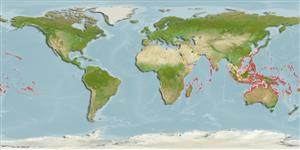Classification / Names
Common names from other countries
Main reference
Size / Weight / Age
Max length : 21.0 cm TL male/unsexed; (Ref. 30573)
Length at first maturity
Lm ?, range 10 - 14 cm
Environment
Marine; reef-associated; non-migratory (Ref. 56001); depth range 0 - 25 m (Ref. 48637), usually 2 - 25 m (Ref. 27115)
Climate / Range
Tropical; 24°C - 28°C (Ref. 27115), preferred ?; 31°N - 34°S, 3°E - 123°W
Distribution
Indo-Pacific: Red Sea south to Transkei, South Africa (Ref. 3145) and east to the Hawaiian and Tuamoto islands, north to southern Japan, south to the southern Great Barrier Reef, New Caledonia, and Rapa (Austral Islands).
Countries | FAO areas | Ecosystems | Occurrences | Introductions
Short description
Dorsal
spines
(total): 9;
Dorsal
soft rays
(total): 24-27;
Anal
spines: 3;
Anal
soft rays: 22 - 24. Brown in color when preserved; with or without fine bluish gray longitudinal lines on body; pale pectoral fins with upper edge narrowly black; pelvic fins brown. Lips blackish brown; median upper teeth tend to be pointed. Dorsal fin base with a prominent black spot larger than 1/2 eye diameter; a smaller spot on base of anal fin. Groove of caudal spine encircled with a narrow black margin. Gill rakers on anterior row:20-24; on posterior row:18-23.
IUCN Red List Status (Ref. 115185)
Threat to humans
Reports of ciguatera poisoning (Ref. 31637)
Human uses
Fisheries: commercial; aquarium: commercial
More information
ReferencesAquacultureAquaculture profileStrainsGeneticsAllele frequenciesHeritabilityDiseasesProcessingMass conversion
Tools
Special reports
Download XML
Internet sources
Estimates of some properties based on models
Phylogenetic diversity index
PD50 = 0.5000 many relatives (e.g. carps) 0.5 - 2.0 few relatives (e.g. lungfishes)
Trophic Level
2.0 ±0.0 se; Based on diet studies.
Resilience
Medium, minimum population doubling time 1.4 - 4.4 years (K=1.00-1.72; tm=2)
Vulnerability
Low to moderate vulnerability (27 of 100)
Price category
